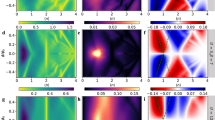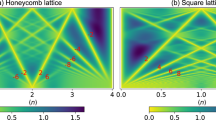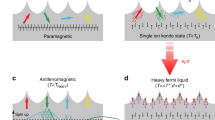Abstract
Interaction-driven charge localization across a quantum phase transition involves a fundamental rearrangement of the low-energy degrees of freedom. This fact challenges weakly interacting quasiparticle descriptions of the physics. The canonical example of such localization is the Mott transition. Here, we present a localization mechanism distinct from ‘Mottness’, which employs strong interactions in an essential way. Our mechanism allows anisotropic localization: phases can arise that are insulating in some directions and metallic in others. The central observation is that localization occurs if an operator that breaks translation invariance, a ‘generalized Umklapp’ operator, becomes relevant in the effective low-energy theory. This does not occur at weak coupling. We realize such localization in a strongly interacting theory described by means of the holographic correspondence. Our model captures key features of metal–insulator transitions including major spectral weight transfer and bad (incoherent) metallic behaviour in the vicinity of the transition. The localized phase has a power law gap in the optical conductivity.
This is a preview of subscription content, access via your institution
Access options
Subscribe to this journal
Receive 12 print issues and online access
$209.00 per year
only $17.42 per issue
Buy this article
- Purchase on Springer Link
- Instant access to full article PDF
Prices may be subject to local taxes which are calculated during checkout





Similar content being viewed by others
References
Imada, M., Fujimori, A. & Tokura, Y. Metal–insulator transitions. Rev. Mod. Phys. 70, 1039–1236 (1998).
Dobrosavljevic, V. in Conductor Insulator Quantum Phase Transitions (eds Dobrosavljevic, V., Trivedi, N. & Valles, J. M. Jr) (Oxford Univ. Press, 2012).
Basov, D. N., Averitt, R. D., van der Marel, D, Dressel, M. & Haule, K. Electrodynamics of correlated electron materials. Rev. Mod. Phys. 83, 471–541 (2011).
Hussey, N. E., Takenaka, K. & Takagi, H. Universality of the Mott–Ioffe–Regel limit in metals. Phil. Mag. 84, 2847–2864 (2004).
Gunnarsson, O., Calandra, M. & Han, J. E. Colloquium: Saturation of electrical resistivity. Rev. Mod. Phys. 75, 1085–1099 (2003).
Limelette, P. et al. Mott transition and transport crossovers in the organic compound κ-(BEDT−TTF)2Cu[N(CN)2]Cl. Phys. Rev. Lett. 91, 016401 (2003).
Emery, V. J. & Kivelson, S. A. Superconductivity in bad metals. Phys. Rev. Lett. 74, 3253–3256 (1995).
Hartnoll, S. A. in Black Holes in Higher Dimensions (ed. Horowitz, G.) Ch. 14 (Cambridge Univ. Press, 2012).
Witczak-Krempa, W. & Sachdev, S. The quasi-normal modes of quantum criticality. Phys. Rev. B 86, 235115 (2012).
Orenstein, J. et al. Frequency- and temperature-dependent conductivity in YBa2Cu3O6+x crystals. Phys. Rev. B 42, 6342–6362 (1990).
Nicoletti, D. et al. An extended infrared study of the (p,T) phase diagram of the p-doped Cu–O plane. New J. Phys. 13, 123009 (2011).
Emery, V. J., Fradkin, E., Kivelson, S. A. & Lubensky, T. C. Quantum theory of the smectic metal state in stripe phases. Phys. Rev. Lett. 85, 2160–2163 (2000).
Vishwanath, A. & Carpentier, D. Two-dimensional anisotropic non-Fermi-liquid phase of coupled Luttinger liquids. Phys. Rev. Lett. 86, 676–679 (2001).
Hartnoll, S. A. & Hofman, D. M. Locally critical resistivities from umklapp scattering. Phys. Rev. Lett. 108, 241601 (2012).
Hartnoll, S. A., Kovtun, P. K., Muller, M. & Sachdev, S. Theory of the Nernst effect near quantum phase transitions in condensed matter, and in dyonic black holes. Phys. Rev. B 76, 144502 (2007).
Hartnoll, S. A. & Herzog, C. P. Impure AdS/CFT correspondence. Phys. Rev. D 77, 106009 (2008).
Liu, Y., Schalm, K., Sun, Y-W. & Zaanen, J. Lattice potentials and fermions in holographic non Fermi-liquids: Hybridizing local quantum criticality. J. High Energy Phys. 2012, 036 (October 2012).
Horowitz, G. T., Santos, J. E. & Tong, D. Optical conductivity with holographic lattices. J. High Energy Phys. 2012, 168 (July 2012).
Horowitz, G. T., Santos, J. E. & Tong, D. Further evidence for lattice-induced scaling. J. High Energy Phys. 2012, 102 (November 2012).
Gibbons, G. W. & Warnick, C. M. The helical phase of chiral nematic liquid crystals as the Bianchi VII(0) group manifold. Phys. Rev. E 84, 031709 (2011).
Nakamura, S., Ooguri, H. & Park, C-S. Gravity dual of spatially modulated phase. Phys. Rev. D 81, 044018 (2010).
Donos, A. & Gauntlett, J. P. Holographic helical superconductors. J. High Energy Phys. 2011, 091 (December 2011).
Donos, A. & Gauntlett, J. P. Black holes dual to helical current phases. Phys. Rev. D 86, 064010 (2012).
Iizuka, N., Kachru, S., Kundu, N., Narayan, P., Sircar, N. & Trivedi, S. P. Bianchi attractors: A classification of extremal black brane geometries. J. High Energy Phys. 2012, 193 (July 2012).
Hartnoll, S. A. & Huijse, L. Fractionalization of holographic Fermi surfaces. Class. Quant. Grav. 29, 194001 (2012).
Hartnoll, S. A. & Radicevic, D. Holographic order parameter for charge fractionalization. Phys. Rev. D 86, 066001 (2012).
D’Hoker, E. & Kraus, P. Charge expulsion from black brane horizons, and holographic quantum criticality in the plane. J. High Energy Phys. 2012, 105 (September 2012).
Emery, V. J., Luther, A. & Peschel, I. Solution of the one-dimensional electron gas on a lattice. Phys. Rev. B 13, 1272–1276 (1976).
Kaplan, D. B., Lee, J-W., Son, D. T. & Stephanov, M. A. Conformality Lost. Phys. Rev. D 80, 125005 (2009).
Donos, A. & Hartnoll, S. A. Universal linear in temperature resistivity from black hole superradiance. Phys. Rev. D 86, 124046 (2012).
Elsasser, S., Wu, D., Dressel, M. & Schlueter, J. A. Power-law dependence of the optical conductivity observed in the quantum spin-liquid compound κ-(BEDT−TTF)2Cu2(CN)3 . Phys. Rev. B 86, 155150 (2012).
Pilon, D. V. et al. Spin induced optical conductivity in the spin liquid candidate herbertsmithite. Preprint at http://arxiv.org/abs/1301.3501 (2013).
Iqbal, N., Liu, H. & Mezei, M. Semi-local quantum liquids. J. High Energy Phys. 2012, 086 (April 2012).
Gouteraux, B. & Kiritsis, E. Generalized holographic quantum criticality at finite density. J. High Energy Phys. 2011, 036 (December 2011).
Hartnoll, S. A. & Shaghoulian, E. Spectral weight in holographic scaling geometries. J. High Energy Phys. 2012, 078 (July 2012).
Anantua, R. J., Hartnoll, S. A., Martin, V. L. & Ramirez, D. M. The Pauli exclusion principle at strong coupling: Holographic matter and momentum space. J. High Energy Phys. 2013, 104 (March 2013).
Nishioka, T., Ryu, S. & Takayanagi, T. Holographic superconductor/insulator transition at zero temperature. J. High Energy Phys. 2010, 131 (March 2010).
Charmousis, C., Gouteraux, B., Kim, B. S., Kiritsis, E. & Meyer, R. Effective holographic theories for low-temperature condensed matter systems. J. High Energy Phys. 2010, 151 (November 2010).
Balasubramanian, K. & McGreevy, J. The particle number in Galilean holography. J. High Energy Phys. 2011, 137 (January 2011).
Anderson, P. W. The Theory of Superconductivity in the High-Tc Cuprate Superconductors (PUP, 1997).
Son, D. T. & Starinets, A. O. Minkowski space correlators in AdS / CFT correspondence: Recipe and applications. J. High Energy Phys. 2002, 042 (September 2002).
Horowitz, G. T. & Roberts, M. M. Holographic superconductors with various condensates. Phys. Rev. D 78, 126008 (2008).
Acknowledgements
We acknowledge helpful discussions with J. Gauntlett, G. Horowitz, S. Kivelson, S. Sachdev, D. Tong and J. Zaanen. S.A.H. is partially supported by a Sloan Research Fellowship and by a DOE Early Career Award.
Author information
Authors and Affiliations
Contributions
A.D. and S.A.H. were both involved in the conception, technical computations and writing up of this work.
Corresponding author
Ethics declarations
Competing interests
The authors declare no competing financial interests.
Supplementary information
Supplementary Information
Supplementary Information (PDF 253 kb)
Rights and permissions
About this article
Cite this article
Donos, A., Hartnoll, S. Interaction-driven localization in holography. Nature Phys 9, 649–655 (2013). https://doi.org/10.1038/nphys2701
Received:
Accepted:
Published:
Issue Date:
DOI: https://doi.org/10.1038/nphys2701
This article is cited by
-
A study on spontaneously translational symmetry breaking in the excited states of holographic superconductor
Journal of High Energy Physics (2024)
-
Mixed-state entanglement for AdS Born-Infeld theory
Journal of High Energy Physics (2023)
-
Impurity-driven metal-insulator transitions in holography
Journal of High Energy Physics (2023)
-
A novel holographic quantum phase transition and butterfly velocity
Journal of High Energy Physics (2022)
-
Interior of helical black holes
Journal of High Energy Physics (2022)



